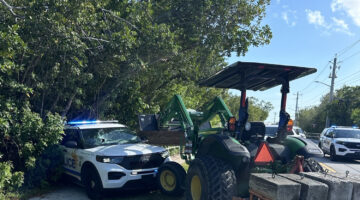Key West storm debris burn rejected
BY PRU SOWERS
KONK LIFE STAFF WRITER
Key West City Commissioners came down in favor of protecting residents’ lungs versus saving almost $2 million when they voted Dec. 5 not to burn storm debris left by Hurricane Irma.
City officials had proposed burning 102,000 cubic yards of vegetation and other landscaping debris collected from city streets after the storm and currently being stored at the far end of Rockland Key. They had hoped to reduce the estimated $2,851,410 cost of hauling the debris up to the mainland for disposal by burning the debris, using a technique called “air curtain burning.” The burning could potentially reduce the debris volume by 98 percent, reducing the hauling cost to $892,150, according to a bid proposal submitted by Charley Toppino & Sons.
Air curtain burning is a FEMA-approved process of reducing storm-related debris piles. First, contractors “fluff” the debris pile to remove non-plant items as well as vegetative items that don’t burn well. Then, the remaining debris are burned and the resulting smoke particles trapped and reburned.
However, even air curtain burning results in smoke that can carry to occupied neighborhoods before being dispersed. On Cudjoe Key, the state Department of Transportation’s debris contractor, MCM Construction, started air curtain burning on Oct. 26 to reduce 213,000 cubic yards of collected debris. Approximately 60 residents of nearby Cudjoe Gardens complained of health problems and the Monroe County Board of County Commissioners recently voted to stop the burning.
Even though a permit for an air curtain burn of Key West debris was granted by FEMA, city commissioners were worried about air pollution and potential lawsuits from residents affected by the smoke.
“I was all for this originally because it’s a huge cost savings,” said Mayor Craig Cates. “But the reality of it is, as I’ve seen the impact it had on the Keys and the residents and downtown Marathon, that didn’t work out good.”
Key West Fire Marshall Alan Averette, questioned by Commissioner Sam Kaufman, said he was told by fire officials monitoring the Cudjoe Key burn that there was minimal smoke. However, there are still health concerns, he said.
“There is no clean smoke. Smoke is bad. All smoke is bad,” Averette said.
The vote to reject all three bids received for air curtain burning was 6-1. Commissioner Margaret Romero was the lone vote in favor. She said that the U.S. Environmental Protection Agency checked the Cudjoe burn site daily while it was still in operation and found no problems. Monroe County fire officials also said there was no negative impact, Romero said.
“If we have all the safety measures in place, I’m not sure what all the negativity is,” she said.
But representatives from three local environmental groups urged the commission not to burn the storm debris. Ed Russo, representing Reef Relief and the Florida Keys Environmental Coalition, said the FEMA permits did not require monitoring of the potential impact of smoke on the ocean and surrounding coral reefs, as well as animal habitats.
“Nobody burns anymore. The liability for it is just incredible,” he said, adding, “If you take an air quality sample, you’ll get shut down very quickly.”
Mark Songer from Last Stand, a local environmental group, agreed with Russo, saying a no-risk smoke level does not exist.
“The negative impacts to human health and the environment far outweigh the cost savings compared with alternative disposal methods,” Songer said.
But Key West Engineering Director Jim Bouquet pointed out there would be another environmental impact of hauling the debris up to the mainland, where it would be burned or shredded. He said it was “doubtful” smoke from burning debris on Rockland Key would float over Key West and Stock Island. It would likely travel in the direction of Navel Air Station Key West, which has already OK’d an air curtain burn on Rockland Key, he said.
“If we don’t burn, we’ll use 1,700 round-trip trucks, probably at minimum. Basically, these are large 60, 70-yard diesel trucks running up and down the Keys for the next month or whatever it might take to get it up to the mainland,” Bouquet said.
But Mayor Cates said he was not comfortable making a decision about burning without input from residents living in the potentially affected areas.
“I’m not just comfortable putting that on somebody’s neighborhood,” he said.
[livemarket market_name="KONK Life LiveMarket" limit=3 category=“” show_signup=0 show_more=0]


No Comment